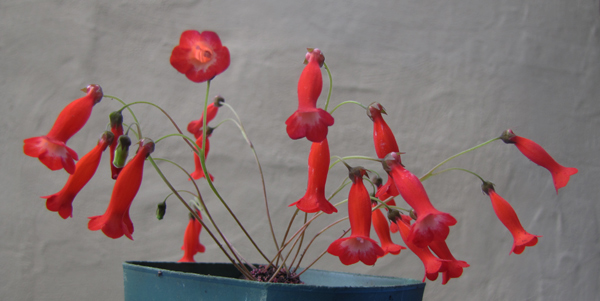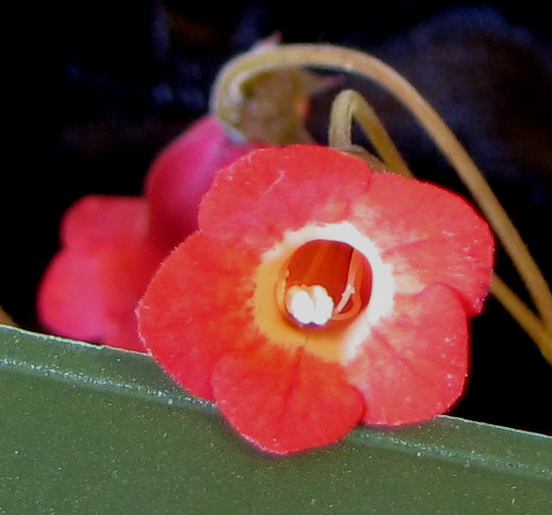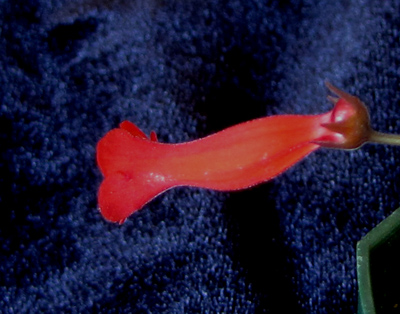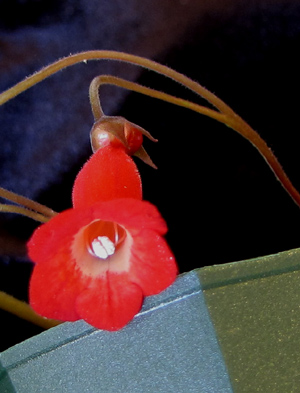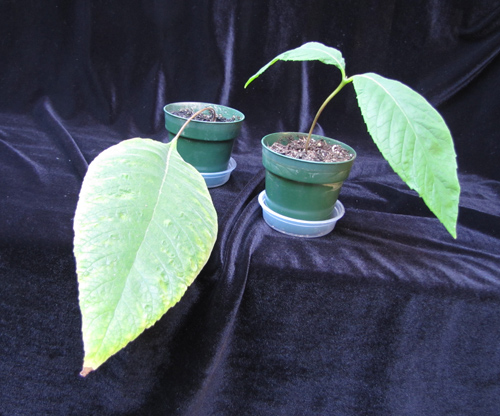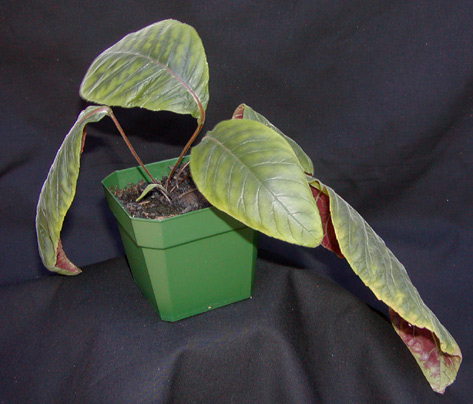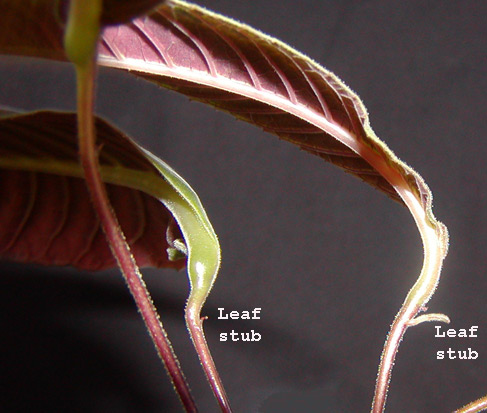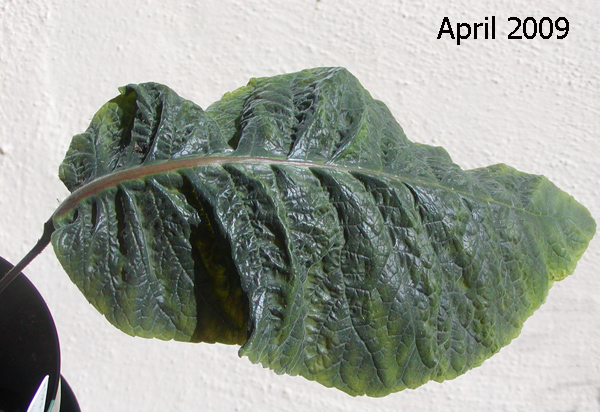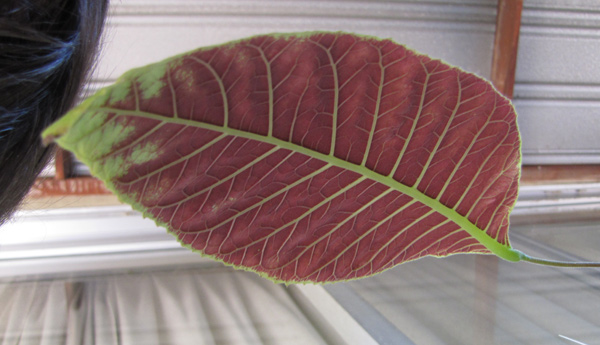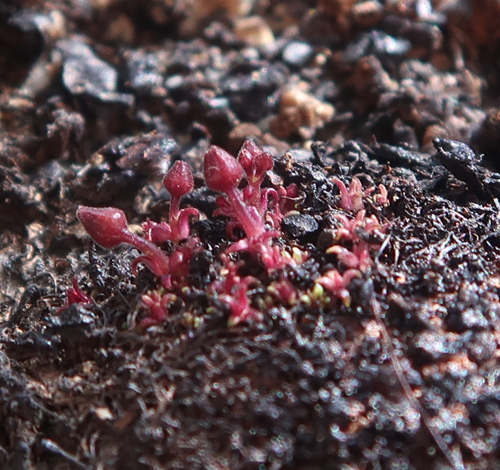Sinningia helioana
This species, formerly known by the holding name "Santa Teresa",
has an interesting growth habit, with (normally) just one stem
and one leaf.
The flowers appear in winter, usually after the stem and its
one leaf have dropped.
|

Sinningia helioana
in bloom in November 2019.
Normally the stem drops before flowering, but in 2019,
the stem remained, even though the leaf fell.
|
- Flower
- Leaves
- Tuber
- Propagation
- Hybridization
- Comparisons
- Feature table
- Publication and etymology
The species Sinningia helioana
(sp. "Santa Teresa" prior to publication) is unusual in a
couple of respects.
The flowers are borne in striking fashion,
on stalks which emerge directly from the tuber.
In this regard, it resembles
Sinningia defoliata.
These two species are in the same large group of related sinningias
(the Corytholoma clade),
although not closely related within that group.
Another species, discovered relatively recently,
S. stapelioides,
which shares the "blooming from the tuber" trait, is in
fact closely related to S. helioana.
|
| |
S. helioana |
S. defoliata |
S. calcaria |
| Growth habit |
One or more (usually) single-leaved wiry stems (4-10 cm long),
giving the appearance of petioles growing directly from tuber |
One or more short (less than 2 cm) single-leaved stems,
giving the appearance of leaves growing directly from tuber |
Short wiry stem with 1-4 leaves at terminal point |
| Stem types |
Two. Flower-bearing and leaf-bearing. |
Two. Flower-bearing and leaf-bearing. |
One. Leaves and flowers borne on same stems. |
| Leaf shape |
1-6 inches long, length-to-width is about 3:1 |
Elliptical, up to 12 inches long, length-to-width usually
less than 2:1 |
2-8 inches long, length-to-width is about 1.5 |
| Leaf margin |
Almost smooth, very slight indentations |
Smooth |
Indented, especially toward the tip |
| Leaf back |
Reddish, secondary veins in low relief |
Green (may be red when small) |
Reddish, secondary veins in high relief |
| Tuber |
Spherical |
Spherical, sometimes with offsets |
Normal, with depressed center ("bagel tuber") |
| Inflorescence |
Cyme with peduncle, emerging directly from tuber, flowers pendant |
Raceme, emerging directly from tuber |
Terminal cyme, very short peduncle (ca. 1 cm long), flowers almost horizontal |
| Flower shape and color |
Tubular, red with white throat |
Tubular, red |
Tubular, orange or orange-red |
Plant Description
|
| Growth |
Determinate |
| Habit |
One or more short stems, usually dark red, each with one leaf.
Sometimes a stem has a second leaf (usually small and deciduous but
rarely larger and persistent). |
| Leaves |
One to several, normally one to a stem. Top dark green, reverse red. |
| Dormancy |
Full dormancy; stems deciduous |
Flowering
|
| Inflorescence |
Cyme with peduncle, emerging directly from tuber |
| Season |
Blooms in autumn |
| Flower |
Tubular, red with white throat |
Horticultural Aspects
|
| From seed |
26 months to bloom, under my conditions, which were not optimal |
| Hardiness |
Unclear. A tuber was not obviously damaged by 32F (0C) in my back yard,
but it did not sprout the next spring and summer. |
| Exposed tuber? |
Yes. Since the leaves form while the stems are still short, it is
useful to expose the upper half of the tuber, this being where the
stems originate. |
| Location |
I get the best blooming results by putting the plant on a shelf in
front of a window, so that the leaf hangs vertically.
I think this approximates how it grows in nature. |
| Recommended? |
Yes and no.
S. defoliata is at least as interesting and easier to bloom.
However, S. helioana is more compact, and the
leaf texture is pleasant.
If you grow it, be sure to give it plenty of water. |
Botany
|
| Taxonomic group |
The aghensis group
of the Corytholoma clade. |
| Location |
Espírito Santo state, Brazil. |
The species is named for Helio de Queiroz Boudet Fernandes, director of
the Mello Leitão Museum in Santa Teresa (MBML), who collected it.

